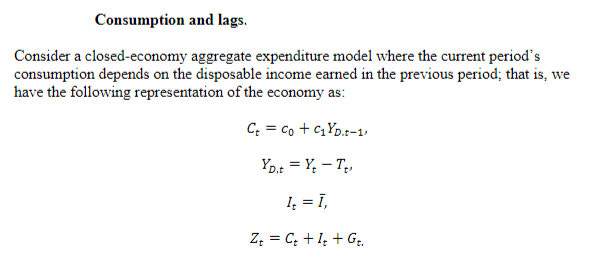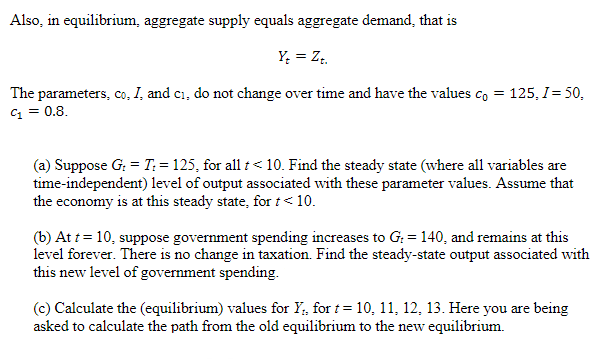(c) Calculate the (equilibrium) values for Y₁, for t= 10, 11, 12, 13. Here you are being asked to calculate the path from the old equilibrium to the new equilibrium.
(c) Calculate the (equilibrium) values for Y₁, for t= 10, 11, 12, 13. Here you are being asked to calculate the path from the old equilibrium to the new equilibrium.
Chapter23: The Aggregate Expenditure Model
Section: Chapter Questions
Problem 10P
Related questions
Question
just c) subpart only please

Transcribed Image Text:Consumption and lags.
Consider a closed-economy aggregate expenditure model where the current period's
consumption depends on the disposable income earned in the previous period; that is, we
have the following representation of the economy as:
Ct = Co + C₁YD.t-1)
YD.t = Y₂ - T₂,
1₂ = 1,
Zt = Ct + It + Gt.

Transcribed Image Text:Also, in equilibrium, aggregate supply equals aggregate demand, that is
Yt = Zt.
The parameters, co, I, and c₁, do not change over time and have the values co = 125, I= 50,
C₁ = 0.8.
(a) Suppose G: = T: = 125, for all t < 10. Find the steady state (where all variables are
time-independent) level of output associated with these parameter values. Assume that
the economy is at this steady state, for t < 10.
(b) At t = 10, suppose government spending increases to G: = 140, and remains at this
level forever. There is no change in taxation. Find the steady-state output associated with
this new level of government spending.
(c) Calculate the (equilibrium) values for Y₁, for t= 10, 11, 12, 13. Here you are being
asked to calculate the path from the old equilibrium to the new equilibrium.
Expert Solution
This question has been solved!
Explore an expertly crafted, step-by-step solution for a thorough understanding of key concepts.
Step by step
Solved in 3 steps

Knowledge Booster
Learn more about
Need a deep-dive on the concept behind this application? Look no further. Learn more about this topic, economics and related others by exploring similar questions and additional content below.Recommended textbooks for you

Exploring Economics
Economics
ISBN:
9781544336329
Author:
Robert L. Sexton
Publisher:
SAGE Publications, Inc

Exploring Economics
Economics
ISBN:
9781544336329
Author:
Robert L. Sexton
Publisher:
SAGE Publications, Inc